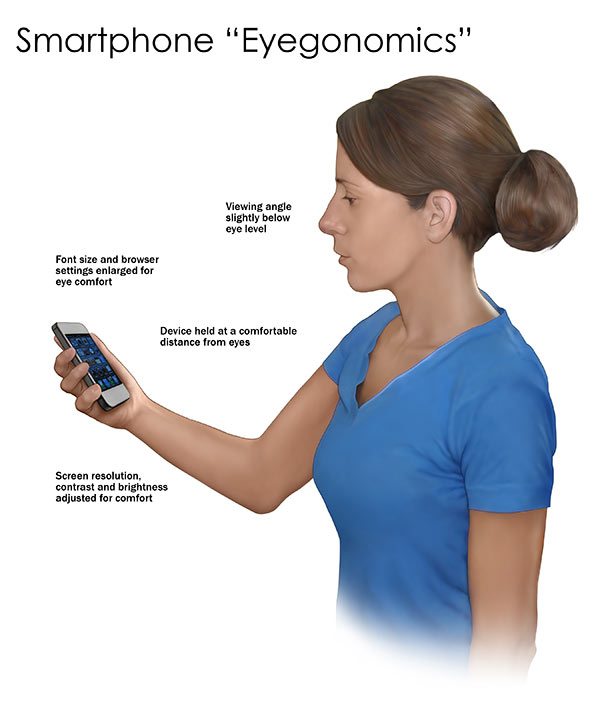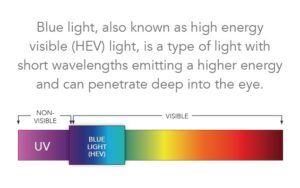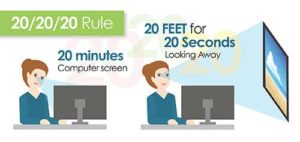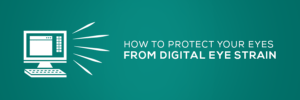 How many hours a day do you spend staring at a screen? One hour? Three-four hours? Maybe even more?
How many hours a day do you spend staring at a screen? One hour? Three-four hours? Maybe even more?
According to reports, people of working age in Australia spend on average more than 6 hours a day staring at screens.
And why wouldn’t they? Digital devices have become a part of daily life for most people. Today’s world runs on digital. From the living room to the board room, we rely on our devices to stay informed, connect with others, and in many cases, earn a living. Mobile devices and computers deliver countless benefits. However, they can also serve up a less beneficial side effect.
What is Digital Eye Strain?
 All that screen staring has led to the growing health concern of digital eye strain, the temporary discomfort felt after two or more hours of digital device use and is associated with staring at a mid-range fixed distance. Numerous electronic devices can cause digital eye strain, be it a smartphone, tablet, computer screen, e-reader, TV or video game.
All that screen staring has led to the growing health concern of digital eye strain, the temporary discomfort felt after two or more hours of digital device use and is associated with staring at a mid-range fixed distance. Numerous electronic devices can cause digital eye strain, be it a smartphone, tablet, computer screen, e-reader, TV or video game.
Overseas studies have shown more than 90% of computer users spend two or more hours a day, and almost one-third spend nine or more hours using digital devices.
Why do digital devices cause eye strain?

Studies show that eyestrain and computer-related visual symptoms occur in 50-90% in computer-oriented workers. There are many culprits that lead to digital eye strain; it is not caused by one isolated event or behaviour.
On average, we blink 15 times per minute, however when we are staring at the screen for a long time, we unconsciously blink much less. This will lead to symptoms of dry, itchy, burning eyes.
Some digital devices have small print font and pixelated images that make it difficult to read and cause our eyes to strain to see clearly.
Work ergonomics and posture is also a contributing factor to digital eyestrain, also by holding devices either too far or too close from our eyes and at the wrong angle.

Blue Light
Blue light, also known as high energy visible (HEV) light, is a type of light with short wavelengths emitting a higher energy and can penetrate deep into the eye. Blue light is the portion of light between UV and visible light that is another cause of digital eye strain. Many digital devices and computer monitors emit blue light, and this cumulative and constant exposure to blue light can increase eye strain. Besides sunlight, digital screens are the most common source of blue light exposure. It can penetrate deep into the eye and cause damage to retinal cells and contribute to long-term eye conditions such as age-related macular degeneration and cataracts.
Here’s why: After blue light enters your eyes, it scatters. Your eyes then have to work extra hard to focus that scattered light, which can contribute to repetitive eye strain and associated headaches, blurred vision, and dry eyes.
Who is most at risk?
Almost everyone, especially those who are on the screen for a significant amount of time at work and when they are used simultaneously or when switching repeatedly from one device to another. With advancing and growing technology in the market, young people are generally more prone to using digital devices.
What can be done?
Device use isn’t likely to dwindle any time soon and you’re probably more likely to hand over the keys to your car than your smartphone. Therefore, it’s vital to find other ways to cut back on your blue light intake. Consider the following five ways to reduce your blue light exposure and decrease the potential onset of digital eye strain.
- Ask your optometrist
An annual trip to the eye doctor is important for the entire family (especially children). Ask our optometrists about the best options to help you or your children reduce eye strain, whether that’ s in the form of computer vision or blue light lenses. Even if you don’t wear corrective lenses, some blue light coatings can be applied to non-prescription eyewear.
s in the form of computer vision or blue light lenses. Even if you don’t wear corrective lenses, some blue light coatings can be applied to non-prescription eyewear. - Observe the 20-20-20 rule
Relieve eye fatigue by giving your eyes a break every 20 minutes and spend 20 seconds looking at something at least 20 feet away. Also, blinking more often helps to moisten your eyes, which may help reduce visual discomfort. Come see our optometrist at Eyecare Plus for more simple tips. - Maintain your digital distance
Find a comfortable working distance from your screen. This is especially important for children since the intensity of light increases exponentially the closer our eyes are to the source. Children have shorter arms and therefore receive a more intense dose of blue light from devices. Children should hold devices as far away from their eyes as is comfortable. Adults are encouraged to hold devices at arm’s length in front of their face. - Dim the lights
Turn down the brightness level of device screens to reduce the amount of blue light exposure, especially during the evening hours. Additionally, as LED and CFL lighting also emit blue light, it would be a good idea to dim those at home or work if possible. - There’s an app for that
Several apps are also available to help reduce blue light emission from devices.
For more information on eye health and eye conditions or to find your local Eyecare Plus optometrist, visit: www.eyecarevision.com.au.
About Optometrists
Optometrists are experts in vision care who diagnose, manage and treat a wide range of vision problems, eye diseases and ocular conditions. By prescribing spectacles, contact lenses, vision aids and other treatments, optometrists help their patients maximise and retain good vision for life.

